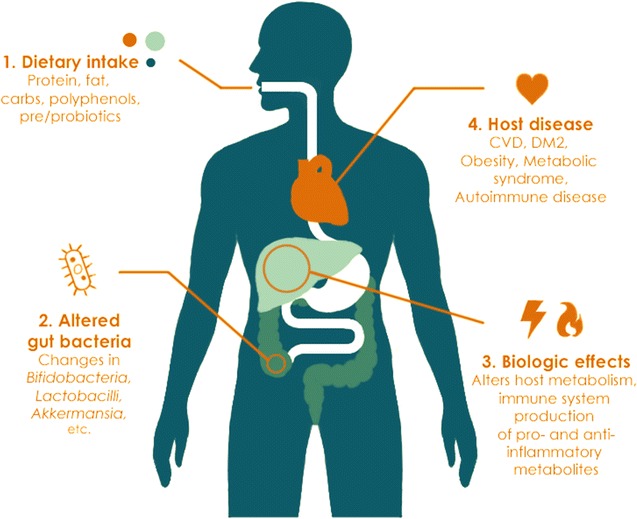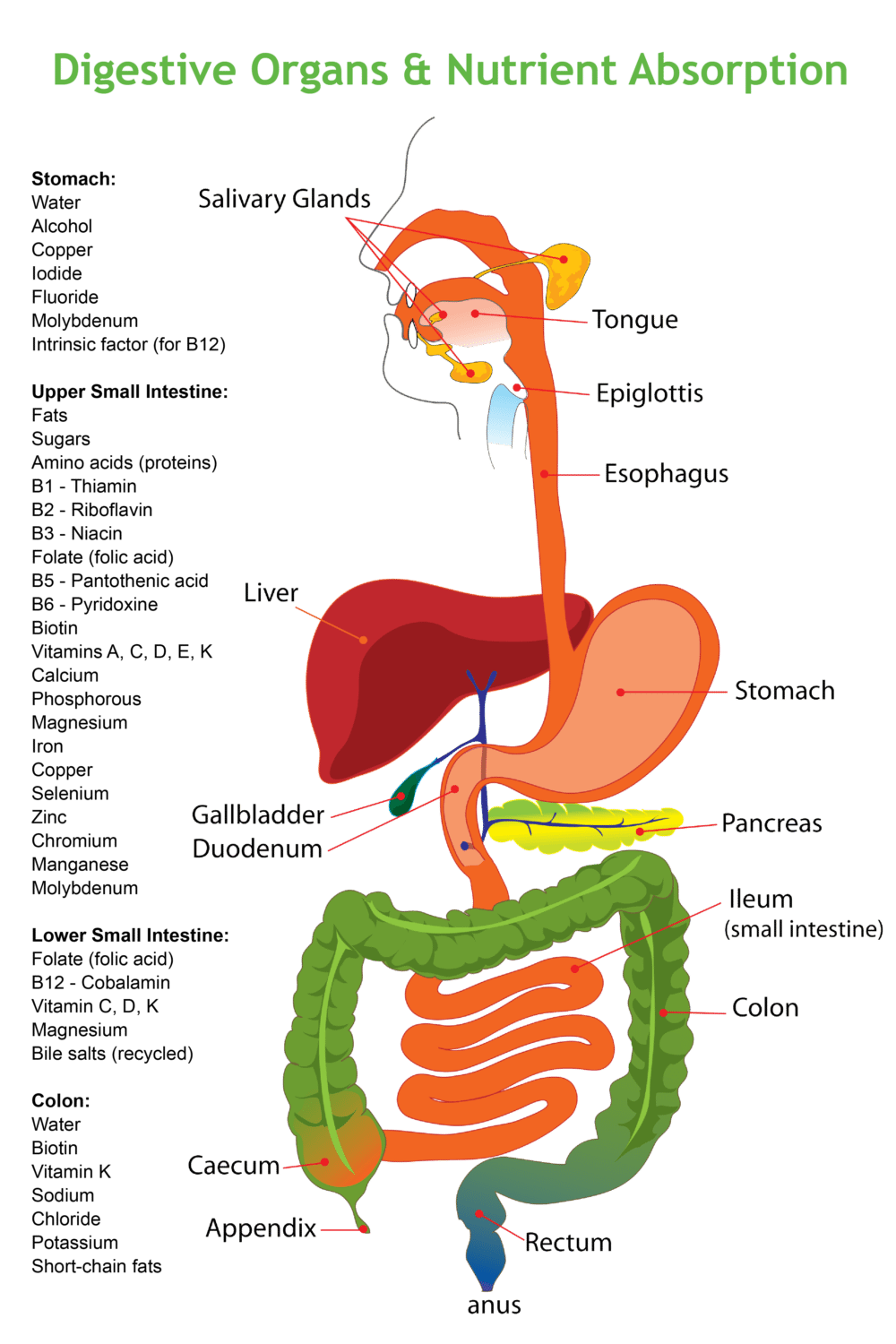Let’s talk about handling parasites, other infections (yeast, bacteria, virus), and gut microbiome imbalances and strategies to address these. All of these can occur in seemingly healthy people and can exist, even coexist, for some time before there are symptoms. I’m going to talk about solutions to rid yourself of some of these, if possible, and why rebalancing is often the best approach.
But first: Alternative Nutrition vs. Western Medicine
In alternative nutrition / alternative medicine, we understand the need for many, many, different strains living along our digestive tract—everywhere from the mouth, through the stomach, into the small intestine and colon… and these can and often should migrate to the other organs that participate in digestion and absorption of nutrients: the liver and pancreas. In Western medicine, detecting a bug is often seen as a bad thing—and sometimes it is, depending on what and where. Here’s the great debate: do we flood the system with antibiotics or other medications in an attempt to eradicate? Or do we take steps to rebalance using an individualized and appropriate nutrient, herbal and/or homeopathic strategy? And while rebalancing is a valid approach based on some 84,000 citations in the medical literature, because it takes patience and dedication to show clients the changes that are important based on their current diet and lifestyle.

I guarantee that if the goal is only to remove bugs, the problem is not fixed.
Why did the bugs infest in the first place? In medical school we were taught that people don’t change. During my Functional Nutrition Masters program and my Nutrition Response Testing program, we were shown ways to empower and step-by-step help clients make changes starting with the “low hanging fruit.” And when that approach is followed, we avoid overwhelm and accomplish the sought-after rebalancing.
The first R of the four is remove—just, it cannot end there.
The first thing we do is remove foods that individual is sensitive to. Foods that cause inflammation and other devastating things also imbalance what lives, or should live, in the gut. A diet that is high in sugar and processed foods, for example, shifts the gut from helpful bacteria to those associated with disease—or at least don’t contribute helping extract nutrients from food, create certain B vitamins and short chain fats needed by the liver and brain especially, balance hormones, remove toxic waste… and their many other functions.
Remove starts with“weed”
Don’t weeds always come back? They do if you don’t fix the garden.
Support the weed step with compatible foods, herbs, and nutrients to speed up how quickly the unwanted critters are weeded out. No chemicals and it an’t be too fast. Everyone is different and an individual may feel worse than when they started. Especially important are digestive enzymes appropriate to that person and what we call “drainage” because your immune system clears things out using “biological warfare”. That’s what it should do!
First it attacks and addresses the invaders.
Because the steps to creating balance vary depending on the health and habits of each of you, it’s not really the bug(s) that matter. If other (diet and lifestyle, the whole person) the bugs just return. You may feel okay for a while but rollercoaster and/or never really return to their full self.
In Nutrition Response Testing we can narrow all of this down to find out the main problematic foods and start their along with a very simple supplement regimen. Why? By reducing the inflammatory components in the correct order of importance and supporting the body with the supplement regimen it most needs at that time, we neither overwhelm the individual, any layer the body truly needs to handle, and consider their budget.

I am worth making changes
Making my wellness a priority is important. I am slowly making changes so I don’t overwhelm myself, but step by step I am heading in a better direction for being healthier.
—DK
How a Healthy Digestive Tract Really Works—Starting With Your Brain
When we’re on the go all the time for whatever reasons; stress, children, deadlines, commutes… and eat at our computer or arguing with family members, we keep our brain signals and the rest of our body in fight or flight mode (sympathetic dominance). Keep doing that over and over again and you won’t have a healthy digestive system.
Brain—digestion tip #1
Eat mindfully. Create boundaries for yourself and others. Take a moment, sit down, and enjoy your food—just be eating and pleasantly conversing if you have company. This puts you in what is called parasympathetic dominance, rest, heal, repair, and digest.
Digestion tip #2—chew
Digestive juices start flowing starting in your mouth. You’re more likely to adequately chew your food rather than gulp it down, you might enjoy the taste and smell more. By chewing your food well you help the rest of your digestive tract process it. For example, if you are eating in a hurry, not only are you in fight or flight mode and not producing many digestive enzymes along the rest of your gut, now you have large food particles that actually need more time and enzymes to digest. Food starts to digest in the mouth when mixed with saliva.
Digestion tip #3—stomach
So many people believe that the stomach is the first organ of digestion. The stomach’s job is pulverize well-chewed food and begin to break down proteins and release iron, vitamin B12, amino acids, calcium and other nutrients. To do this you need enough stomach acid. Medicines that inhibit producing stomach acid (like those often prescribed for reflux, ulcers…) prevent release of vital nutrients from food and can be a main cause of low B12 needed for energy, low calcium for healthy bones and other functions, low iron to carry oxygen, even muscle wasting if the proteins are not being made into their individual amino acids.
One main function of adequate stomach acid is to kill or neutralize infections bacteria, parasites, yeast, and even viruses (which aren’t technically alive).
Small intestine—digestion tip #4—so it’s what you eat (ingestion), how it’s processed (digestion), and next up is absorption.
The various sections of the small intestine absorb different nutrients assuming it is healthy along it’s 20-22 feet of length—the length of half a tennis court. Your liver, gall bladder, and pancreas all contribute to this process. At the very top of the small intestine, the pancreas contributes many different enzymes to continue the breakdown of ingested food; the liver makes bile which is stored in the gall bladder and primarily helps emulsify fat so that its enzymes and also those from the pancreas can help digest it.
Because the liver is also an organ of elimination (along with kidneys, and skin and lungs especially if the liver and kidneys are not efficient) these also enter the small intestine at its topmost section.
Starting at the top of the small intestine there is gradually increasing amounts of probiotic bacteria along its length. These help process and eliminate toxic waste, balance hormones, digest certain foods, and feed the gut lining. For example, gut bacteria along with the liver are one of the main systems that convert the T4 made by the thyroid into its active form T3. Microbial imbalances limit this conversion and are one of the main reasons so many are prescribed thyroid medication.
The delicate balance:
If the small intestine or colon is compromised—inflamed, imbalanced microbiome, some people call this “leaky gut”, Waste products (whether environmental or made by our own bodies) go back into the blood and lymph causing the liver and kidneys to do double the work. Very commonly, skin acne is really the skin taking over elimination.
Further, foods that are not ready for absorption, e.g. not fully digested, move prematurely out of the digestive tract and activate the immune system that sits on the other side. Now we see headaches, joint aches, fatigue, moods, eczema and more unwanted sensations.
This brings us to the Colon—Digestion Tip #5
There may be 5-10 pounds of bacteria living in the colon—much more dense than the small intestine. And these are different strains than what should live in the small intestine. The main function of the colon is to work in concert with the kidneys to balance electrolytes and fluids. Yet its dense population of probiotic bugs will make the healthy short length fats (butyrate and others) that are a main food source for the liver and brain. Bacteria in the colon also can make the B vitamins: Thiamine, folate, biotin, riboflavin, and panthothenic acid; they also make vitamin K2 which partners with vitamin D3 to support healthy bones and muscle.
Digestion Tip #6—keep things moving!
This is called transit time. Depending on age and gender there is an ideal range of time for food to move from chew, to swallow, in the stomach, through the small intestine, and out of the colon.
Too much time in transit and toxic waste remains too long keeping the gut lining inflamed. Even if you have daily bowel movements, your transit time may be too long. And it may be too fast if they are very loose and/or float.
- Transit time for adult men is 30-31 hours
- Transit time for adult women whose colon is longer than men is 36-41 hours
- Transit time for adolescents is nearly 43 hours
- Transit time for seniors becomes a bit faster at 29 hours
Take the Blu Poo test. Completely non-toxic and non-radioactive like traditional transit time tests. Call me!
Now that you understand a healthy gut orchestra—what happens in metabolic chaos?
Well, anything due to the complex relationship between all these components. See my related article here: http://synergynutrition.info/2023/06/25/gut-microbiome-health/
Using the 4Rs
In the First R—“weed”
I like to use botanicals. Some of my vendors use herbal combinations like olive leaf, goldenseal, bilberry, black walnut, garlic, oregano, and others. A unique approach is a product called Zymex II made by standard process which is primarily a series of enzymes and some anti-oxidants that “digests”, if you will, parasitic infections which are far more common than most people realize. Another favorite botanical is wormwood, also known as Artemisia Annua. Please don’t go out and self-medicate with these as they should be used in certain circumstances. That’s why I take constant information about health history, changes in status (especially pregnancy and lactation), and use Nutrition Response Testing to see what is the best for your situation.
Caution: When you learn you have a bug with whatever method of testing, please also don’t just jump on a medication, nutritional supplement or botanical problem and think “I’ve treated my problem.” You haven’t. We know that many other symptoms: Heartburn, gas, indigestion, bloating, constipation, diarrhea, congestion… need to be healed. They may have been caused by the problem or be the cause.
Other issues like resulting leaky gut, autoimmune, psoriasis, multiple sclerosis, fibromyalgia, chronic fatigue, headaches are all components that must be addressed to restore health.
Again, the weed step includes any diet and lifestyle steps that caused the problem in the first place.
The Second R—replace.
Several prongs to this:
- Replacing inflammatory foods with nourishing and tasty foods that don’t inflame. There are many options these days. I can help with this. In the 16 years of helping people with diet and lifestyle choices, I’ve built the website at https://OurNutritionKitchen.com Many ideas from fast and simple to elegant.
- Replacing stomach acids and enzymes, other enzymes and, as needed, liver, gall bladder, and pancreatic support so they can begin to manufacture these.
- Replacing the unhelpful and often toxic bugs remedied in the weed step with helpful strains. Probiotics alone don’t do this. There really is no such thing as reinoculated unless what was in the gut was wiped out by antibiotics, opioids, and other medications; constant toxic exposures… and now there is space for added probiotics to “park”.
The most effective way is to “feed”. This includes plenty of their food—fibrous vegetables including root vegetables, other fibers we don’t necessarily digest and minimal sugary processed starchy foods that encourage the wrong group of critters. This brings us to...
The Third R—Reinoculate.
Well, there really is no such thing excepting a newborn, someone who has had a massive course of antibiotics, or chemo or other medications that wipe out their immune/gut system.
- Newborns are not sterile despite dogma. If they are born-c-section then they get the skin microbiome of mom. If they are born vaginally then they get mom's gut flora.
- Antibiotics wipe out all bacteria but have no effect on yeast, viruses, or parasites. Next up: These others now have space to grow. Providing the correct prebiotics and probiotics during these medication choices is vital.
The Fourth R—Repair.
- Repair the gut lining. It takes having the right microbiome, the right diet, the right (but not too many) supplements, the right lifestyle habits, and more to do this.
- Please, pretty please, don't guess on supplements with the following exceptions: Vitamin D labs MUST be above 55 ng/ml. There are other functional considerations.
This is the journey.
In so many ways this can be looked at as
- “weed” and support better digestion,
- “feed and seed” to encourage rebalancing, then
- “rebuild and maintain.”
It’s not that complicated for clients who maintain their treatment frequency so we can move through each of the steps as the body is ready to do so.
Do you want to feel great again?
There is hope and I can help.
Call me 907-222-1824 and mention this article to get a new client discount, just $59 (regularly $145)
Select References
García-Montero, C., Fraile-Martínez, O., Gómez-Lahoz, A. M., Pekarek, L., Castellanos, A. J., Noguerales-Fraguas, F., Coca, S., Guijarro, L. G., García-Honduvilla, N., Asúnsolo, A., Sanchez-Trujillo, L., Lahera, G., Bujan, J., Monserrat, J., Álvarez-Mon, M., Álvarez-Mon, M. A., & Ortega, M. A. (2021). Nutritional Components in Western Diet Versus Mediterranean Diet at the Gut Microbiota-Immune System Interplay. Implications for Health and Disease. Nutrients, 13(2), 699.
Hills, R. D., Jr, Pontefract, B. A., Mishcon, H. R., Black, C. A., Sutton, S. C., & Theberge, C. R. (2019). Gut Microbiome: Profound Implications for Diet and Disease. Nutrients, 11(7), 1613.
Merra, G., Noce, A., Marrone, G., Cintoni, M., Tarsitano, M. G., Capacci, A., & De Lorenzo, A. (2020). Influence of Mediterranean Diet on Human Gut Microbiota. Nutrients, 13(1), 7.
Singh, R. K., Chang, H. W., Yan, D., Lee, K. M., Ucmak, D., Wong, K., Abrouk, M., Farahnik, B., Nakamura, M., Zhu, T. H., Bhutani, T., & Liao, W. (2017). Influence of diet on the gut microbiome and implications for human health. Journal of translational medicine, 15(1), 73
Strasser, B., Wolters, M., Weyh, C., Krüger, K., & Ticinesi, A. (2021). The Effects of Lifestyle and Diet on Gut Microbiota Composition, Inflammation and Muscle Performance in Our Aging Society. Nutrients, 13(6), 2045.
Wastyk, H. C., Fragiadakis, G. K., Perelman, D., Dahan, D., Merrill, B. D., Yu, F. B., Topf, M., Gonzalez, C. G., Van Treuren, W., Han, S., Robinson, J. L., Elias, J. E., Sonnenburg, E. D., Gardner, C. D., & Sonnenburg, J. L. (2021). Gut-microbiota-targeted diets modulate human immune status. Cell, 184(16), 4137–4153.e14.

Leave a Reply
You must be logged in to post a comment.